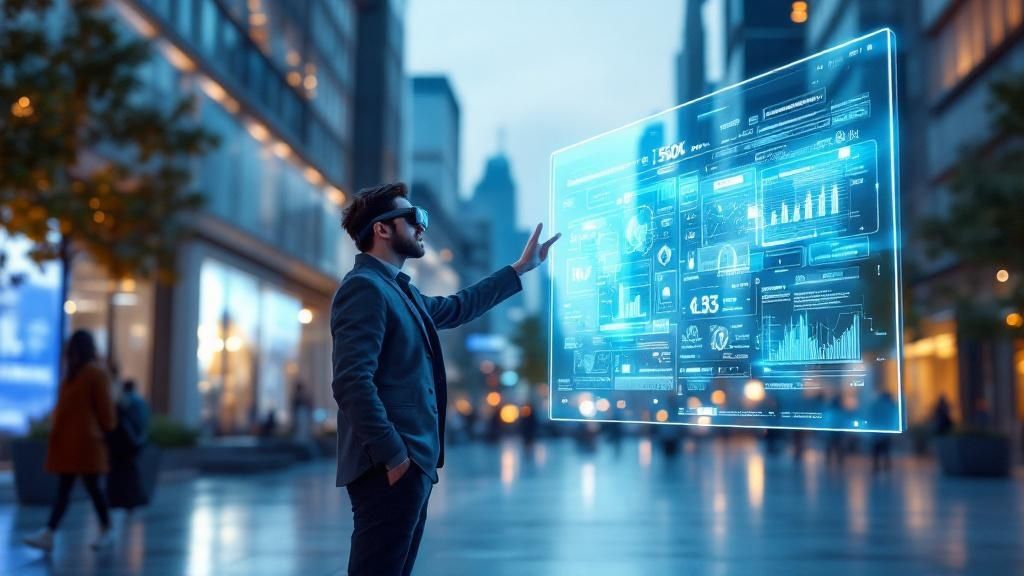
Meta Description: Discover the advertising of the future, driven by AI, personalization, and immersive content. Learn how to adapt your strategy for a privacy-first world.
Struggling to cut through the noise with ads that feel outdated and ineffective? The classic "one-size-fits-all" message is no longer working, leaving many marketers and creators feeling like they're shouting into the void. As consumer expectations shift, the challenge is to deliver relevant, engaging experiences without being intrusive. The advertising of the future isn't about more ads; it's about smarter, more personal connections. This guide breaks down the essential trends—from AI-driven precision to immersive AR—and offers practical steps to prepare your brand for what's next. Get ready to turn disruption into your biggest opportunity.

How AI Is Rewriting the Rules of Advertising
Artificial intelligence is no longer a far-off concept; it’s the engine running under the hood of today's most effective advertising campaigns. AI is fundamentally changing the game by processing vast amounts of information and spotting opportunities on a scale humans simply can't match. For digital marketers and agencies, AI acts as the ultimate strategist. It sifts through mountains of data to find subtle patterns and trends, turning raw numbers into smart, actionable marketing moves. This shift is empowering a new wave of advertising tools and strategies that are more efficient and impactful than ever before.
From Manual Guesswork to Predictive Precision
One of the biggest changes AI brings to the advertising of the future is the leap from reactive analysis to predictive strategy. Instead of just reviewing past campaign performance, AI models can now forecast consumer behavior with impressive accuracy. For marketers, this means you can anticipate what a customer needs before they even type it into a search bar. For example, an e-commerce brand can use AI to identify which customers are likely to buy a new product based on their browsing habits and social media sentiment. This results in timely, relevant ads that feel helpful, not intrusive, boosting ROI and customer loyalty.
Programmatic advertising is another area where AI excels. Algorithms optimize ad placements in real-time, bidding for space and selecting the perfect creative for each individual viewer. This automated process ensures marketing budgets are spent with maximum efficiency, reaching the right people at the perfect moment.
Empowering Agencies and Creators Alike
This AI-driven shift benefits everyone in the industry. For ad agencies, the tedious tasks of manual campaign management are fading, allowing them to focus on high-level strategy and the creative vision that AI can't replicate. You can learn more about this strategic pivot in our guide on how to use AI for marketing.
For independent creators and solopreneurs, AI is a powerful equalizer, making sophisticated advertising accessible for the first time. Tools are now available to:
- Generate Ad Copy: Instantly create and A/B test multiple versions of compelling ad copy.
- Create Visual Content: Produce stunning images or short video clips without needing a design team.
- Segment Audiences: Discover niche audiences with high conversion potential that were previously overlooked.
By letting AI handle the technical heavy lifting, creators can focus on what they do best: storytelling and community building. For instance, AI can seamlessly help create captivating AI video ads that resonate with target audiences. The trend is clear: mastering these tools is no longer optional—it's essential for staying competitive.
Delivering Hyper-Personalization at Scale

The days of broadcasting a single ad to a massive, generic audience are over. Modern consumers don't just appreciate personalization—they expect it. The advertising of the future isn't about casting a wider net; it's about crafting the perfect, tailored message for each individual. The challenge has always been achieving this at scale. Now, technology provides the solution, allowing brands to create unique experiences for every person who interacts with them. This moves beyond simply using a first name in an email to delivering dynamically relevant content in real-time.
The Magic of Dynamic Creative Optimization (DCO)
Dynamic Creative Optimization (DCO) is an intelligent ad-building engine that makes hyper-personalization possible. Instead of creating one static ad, marketers provide the DCO platform with a library of components—images, headlines, calls-to-action, and more. The platform then assembles the ideal ad for each viewer in real-time based on data like their location, browsing behavior, and past purchases. One campaign can generate thousands of unique variations, ensuring each ad resonates perfectly.
For an e-commerce brand, DCO could:
- Show a shopper an ad featuring the exact sneakers they left in their cart.
- Display those sneakers in blue, based on their preference history.
- Adjust the headline to mention local weather, making a product like running shorts seem more appealing.
Building Trust Through Privacy-First Personalization
This level of personalization must be built on a foundation of trust. Consumers are increasingly aware of how their data is used, and overly invasive ads can be just as damaging as generic ones. The solution is to lean into first-party data—information customers provide willingly, such as email sign-ups or purchase history. Using this data respectfully turns personalization from a potential privacy concern into a value-added service that enhances the customer journey.
This approach pays dividends. Research shows that personalized experiences foster loyalty, and brands that are transparent about data usage build stronger relationships. To effectively implement these ideas, explore our guide on marketing automation best practices. By combining smart technology with a commitment to user privacy, you can deliver the experiences customers demand.
The Rise of Immersive and Interactive Content
Passive advertising is losing its effectiveness. In a world where attention is the most valuable currency, simply showing someone an ad is no longer enough. The advertising of the future isn't about being seen; it’s about being experienced. Brands must create interactive content that captivates and engages audiences on a deeper level. This shift requires moving beyond static formats and embracing dynamic experiences that invite participation. From bite-sized videos to augmented reality, the goal is to make advertising a memorable part of the user's journey.
The Unstoppable Power of Short-Form Video
Short-form video has become the dominant format for brand discovery and audience connection. Platforms like TikTok, Instagram Reels, and YouTube Shorts have conditioned users to expect dynamic, visually engaging content that gets straight to the point. However, the window to capture attention is incredibly small—often just a few seconds.
To succeed, marketers must tailor content to the platform’s culture:
- TikTok: Prioritize authenticity and participate in current trends. The best ads feel like native content.
- Instagram Reels: Focus on high-quality visuals and polished storytelling that aligns with the platform's aesthetic.
- YouTube Shorts: Deliver immediate value through educational or entertaining "how-to" content.
Augmented Reality: Blurring Digital and Physical Worlds
Augmented Reality (AR) transforms advertising from a one-way message into an interactive playground. AR allows users to overlay digital elements onto their real-world environment using their smartphone camera, creating a virtual "try-before-you-buy" experience. For example, a makeup brand can let users test lipstick shades virtually, while a furniture company can show how a sofa would look in their living room. These memorable interactions build consumer confidence and reduce the friction in the buying process, leading to higher engagement and conversion rates. As this technology becomes more mainstream, exploring the best AI tools for content creation will be key to developing compelling AR assets.

Shoppable Content: Closing the Loop
The ultimate goal is to shorten the path from discovery to purchase. Shoppable content achieves this by integrating e-commerce functionality directly into the content itself. Imagine a viewer watching a creator's video and tapping on an item they're wearing to see the price and add it to their cart without ever leaving the app. This frictionless experience captures purchase intent in the moment it occurs. By blending content and commerce, shoppable media turns ads from interruptions into helpful, convenient experiences that add value to the consumer's day.
Navigating a Privacy-First Advertising World
The foundation of digital advertising is shifting. For years, the industry relied on third-party cookies to track users across the web, but that era is ending. The advertising of the future must be built on a more sustainable foundation: consumer trust and respect for privacy. With regulations like GDPR and the phase-out of cookies, the old playbook is obsolete. This seismic shift forces marketers, agencies, and creators to rethink how they reach audiences without relying on cross-site tracking. The solution isn't to find a clever workaround; it's to embrace this new reality as a strategic advantage.

The Strategic Power of First-Party Data
Instead of tracking users across the web, the focus now is on earning data directly from them. First-party data—information customers willingly share—is the new gold standard. When a customer subscribes to a newsletter, joins a loyalty program, or makes a purchase, they are providing valuable insights wrapped in trust. This data is not only more ethical but also more accurate, allowing you to build stronger, more resilient customer relationships based on a direct understanding of their needs and preferences. It's a fundamental move from a transactional mindset to a relational one.
The Resurgence of Contextual Advertising
While first-party data is excellent for engaging your existing audience, contextual advertising is making a powerful comeback for reaching new customers. The logic is simple: instead of targeting the person, you target the moment. Ads are placed based on the content a user is actively consuming.
- Someone reading about marathon training sees an ad for running shoes.
- A user watching camera reviews is shown ads for photography accessories.
This approach respects privacy because it doesn't require personal data. It aligns the ad with a person's immediate interest, making it feel more relevant and less intrusive. This relevance ultimately boosts performance and improves the overall user experience.
Turning Transparency into a Competitive Advantage
In this new era, transparency is a brand-building superpower. Consumers are more skeptical than ever about data usage. By being open and honest about why you're collecting information and what value you'll provide in return, you can differentiate your brand. Giving users meaningful control over their data builds trust and fosters loyalty. Brands that respect their customers' privacy will win in the long run. This is the core of building a sustainable and effective strategy for the advertising of the future.
👉 Try MediaWorkbench.ai for free – schedule your posts and generate AI content in one place!
Preparing for Tomorrow's Advertising
The advertising of the future is smarter, more personal, and deeply immersive. We’ve seen how AI is becoming the strategic brain behind campaigns, enabling hyper-personalization at scale. Meanwhile, interactive content like short-form video and AR is essential for capturing attention in a crowded digital landscape. However, all of this hinges on a foundation of consumer trust built through privacy-first practices. The key takeaway is that technology should be used to enhance human creativity and build genuine relationships, not just to automate old processes. Diving into practical applications, like machine learning code examples, can demystify the tech driving these changes.
To stay ahead, brands must adopt forward-thinking strategies, such as those found in Web3 marketing automation best practices. The time to build your future-proof advertising strategy isn't tomorrow—it’s now.
Conclusion: Embrace the Future of Advertising
The advertising landscape is evolving at a breakneck pace, driven by AI, personalization, and a renewed focus on consumer privacy. The key to success is no longer about shouting the loudest but about connecting the smartest. By embracing AI-driven insights to understand your audience, using immersive content to create memorable experiences, and building trust through transparent, privacy-first practices, you can create advertising that people actually welcome.
This is your opportunity to move beyond outdated tactics and build a more effective, respectful, and resilient marketing strategy. Ready to put these ideas into action? Explore how MediaWorkbench.ai can help you automate your social media, generate high-performing content, and prepare your brand for the advertising of the future. Start your free trial today and transform your content workflow.

